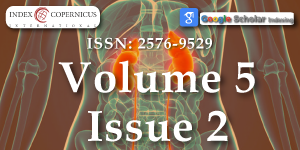Usefulness of foot-to-foot bioimpedance analysis for assessing volume status in chronic hemodialysis patients at the Aristide Le Dantec University Hospital (Senegal)
Main Article Content
Abstract
Introduction: Determination of dry weight is one of the daily goals to achieve in hemodialysis. The aim of this study was to validate the use of bioelectrical impedance analysis (BIA) in estimation of dry weight in a population of Senegalese chronic hemodialysis patients.
Patients and methods: A 9-week cross-sectional study was carried out at the hemodialysis unit of Aristide Le Dantec University Hospital. Adult patients with no previous hospital history were included. The total body water (TBW) was measured with a single frequency bioelectric impedance foot-to-foot analyzer, before and after six successive hemodialysis sessions. These results were compared with those from clinical measurements with the Watson equation using a Student’s t-test and Bland-Altman analysis.
Results: 264 measurements were made in 22 patients (46.6 years, 54.5% men, 92.3 months on dialysis, 62.7 kg mean dry weight). A significant reduction in weight (ΔWeight = 2.0 ± 1.1 kg; p < 0.0001) and in TBW measured by the BIA (ΔTBWBIA = 3.3 ± 1.0 liters; p < 0.0001)) or calculated by Watson’s equation (ΔTBWWatson = 0.5 ± 0.2 liter; p = 0.0001) was observed. There was a strong linear correlation and agreement between the 2 TBW measurements in pre-dialysis. In post-dialysis the concordance diagram indicated a bias = –2.2 and wide agreement limits.
Conclusion: The BIA allows reproducible and reliable measurements and a fair estimate of the TBW in pre-dialysis.
Article Details
Copyright (c) 2021 Keita N, et al.

This work is licensed under a Creative Commons Attribution 4.0 International License.
Wizemann V, Wabel P, Chamney P, Zaluska W, Moissl U, et al. The mortality risk of overhydration in haemodialysis patients. Nephrol Dial Transplant. 2009: 24: 1574-1579. PubMed: https://pubmed.ncbi.nlm.nih.gov/19131355/
Dou Y, Cheng X, Liu L, Bai X, Wu L, et al. Development and validation of a new dry weight estimation method using single frequency bioimpedance in hemodialysis patients. Blood Purif. 2011; 32: 278– 285. PubMed: https://pubmed.ncbi.nlm.nih.gov/21876350/
Ozkahya M, Ok E, Toz H, Asci G, Duman S, et al. Long-term survival rates in haemodialysis patients treated with strict volume control. Nephrol Dial Transplant. 2006; 21: 3506–3513. PubMed: https://pubmed.ncbi.nlm.nih.gov/17000733/
Moissl UM, Wabel P, Chamney PW, Bosaeus I, Levin NW, et al. Body fluid volume determination via body composition spectroscopy in health and disease. Physiol Meas. 2006; 27: 921–933. PubMed: https://pubmed.ncbi.nlm.nih.gov/16868355/
Chamney PW, Wabel P, Moissl UM, Müller MJ, Bosy-Westphal A, et al. A whole-body model to distinguish excess fluid from the hydration of major body tissues. Am J Clin Nutr. 2007; 85: 80–89. PubMed: https://pubmed.ncbi.nlm.nih.gov/17209181/
Davies SJ, Garcia Lopez E, Woodrow G, Donovan K, Plum J, et al. Longitudinal relationships between fluid status, inflammation, urine volume and plasma metabolites of icodextrin in patients randomized to glucose or icodextrin for the long exchange. Nephrol Dial Transplant. 2008; 23: 2982 –2988. PubMed: https://pubmed.ncbi.nlm.nih.gov/18456678/
Davies SJ, Davenport A. The role of bioimpedance and biomarkers in helping to aid clinical decision-making of volume assessments in dialysis patients. Kidney Int. 2014; 86: 489-496. PubMed: https://pubmed.ncbi.nlm.nih.gov/24918155/
Kooman JP, Van Der Sande FM, Leunissen KM. Wet or dry in dialysis—can new technologies help? Semin Dial. 2009; 22: 9-12. PubMed: https://pubmed.ncbi.nlm.nih.gov/19250443/
Watson PE, Watson ID, Batt RD. Total body water volumes for adult males and females estimated from simple anthropometric measurements. Am J Clin Nutr. 1980; 33: 27-39. PubMed: https://pubmed.ncbi.nlm.nih.gov/6986753/
Cridlig J, Alquist M, Kessler M, Nadi M. Formulation of a dry weight bioimpedance index in hemodialysis patients. Int J Artif Organs. 2011; 34: 1075-1084. PubMed: https://pubmed.ncbi.nlm.nih.gov/22183521/
Kurtin PS, Shapiro AC, Tomita H, Raizman D. Volume Status and Body Composition of Chronic Dialysis Patients: Utility of Bioelectric Impedance Plethysmography. Am J Nephrol. 1990; 10: 363-367. PubMed: https://pubmed.ncbi.nlm.nih.gov/2080787/
Asmat H, Iqbal R, Sharif F, Mahmood A, Abbas A, et al. Validation of Bioelectrical Impedance Analysis for Assessing Dry Weight of Dialysis Patients in Pakistan. Saudi J Kidney Dis Transpl. 2017; 28: 285-291. PubMed: https://pubmed.ncbi.nlm.nih.gov/28352009/
Donadio C, Consani C, Ardini M, BernabinI G, Caprio F, et al. Estimate of Body Water Compartments and of Body Composition in Maintenance Hemodialysis Patients: Comparison of Single and Multifrequency Bioimpedance Analysis. J Ren Nutr. 2005; 15: 332-344. PubMed: https://pubmed.ncbi.nlm.nih.gov/16007563/
Maggiore Q, Nigrelli S, Ciccarelli C, Grimaldi C, Rossi GA, et al. Nutritional and prognostic correlates of bioimpedance indexes in hemodialysis patients. Kidney Int. 1996; 50: 2103–2108. PubMed: https://pubmed.ncbi.nlm.nih.gov/8943496/
Piccoli A. Identification of operational clues to dry weight prescription in hemodialysis using bioimpedance vector analysis. Kidney Int. 1998; 53: 1036–1043. PubMed: https://pubmed.ncbi.nlm.nih.gov/9551415/
Di Iorio BR, Scalfi L, Terracciano V, Bellizzi V. A systematic evaluation of bioelectrical impédance measurement after hemodialysis session. Kidney Int. 2004; 65: 2435–2440. PubMed: https://pubmed.ncbi.nlm.nih.gov/15149357/
Chertow GM, Lazarus JM, Lew NL, MA L, Lowrie EG. Development of a population-specific regression equation to estimate total body water in hemodialysis patients. Kidney Int. 1997; 51: 1578-1582. PubMed: https://pubmed.ncbi.nlm.nih.gov/9150475/

